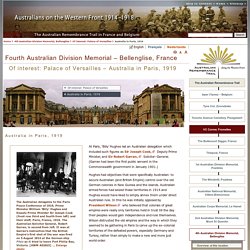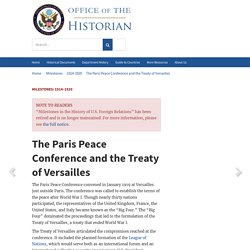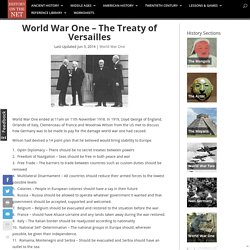

4th Australian Division Memorial, Bellenglise. Australia in Paris, 1919 The Australian delegates to the Paris Peace Conference of 1919, Prime Minister William ‘Billy’ Hughes and Deputy Prime Minister Sir Joseph Cook (front row third and fourth from left) and their staff, Paris, France, 1919.

The Australian Solicitor General, Robert Garran, is second from left. It was at Garran’s instruction that the British Empire’s first shot of the war was fired on 5 August 1914 at the German ship Pfalz as it tried to leave Port Philip Bay, Victoria. [AWM A02615] ... Enlarge photo. Milestones: 1914–1920. The Paris Peace Conference convened in January 1919 at Versailles just outside Paris.

Treaty of Versailles. World War One - The Treaty of Versailles - History on the Net. World War One ended at 11am on 11th November 1918.

In 1919, Lloyd George of England, Orlando of Italy, Clemenceau of France and Woodrow Wilson from the US met to discuss how Germany was to be made to pay for the damage world war one had caused. Wilson had devised a 14 point plan that he believed would bring stability to Europe. Open Diplomacy – There should be no secret treaties between powers Freedom of Navigation – Seas should be free in both peace and war Free Trade – The barriers to trade between countries such as custom duties should be removed Multilateral Disarmament – All countries should reduce their armed forces to the lowest possible levels Colonies – People in European colonies should have a say in their future Russia – Russia should be allowed to operate whatever government it wanted and that government should be accepted, supported and welcomed.
Treaty of Versailles - World War I. The treaty, negotiated between January and June 1919 in Paris, was written by the Allies with almost no participation by the Germans.

The negotiations revealed a split between the French, who wanted to dismember Germany to make it impossible for it to renew war with France, and the British and Americans, who did not want to create pretexts for a new war. The eventual treaty included fifteen parts and 440 articles. Part I created the Covenant of the New League of Nations, which Germany was not allowed to join until 1926. Part II specified Germany’s new boundaries, giving Eupen-Malm[eacute]dy to Belgium, Alsace-Lorraine back to France, substantial eastern districts to Poland, Memel to Lithuania, and large portions of Schleswig to Denmark.
Part III stipulated a demilitarized zone and separated the Saar from Germany for fifteen years. The German government signed the treaty under protest. The Reader’s Companion to Military History. Aftermath of the First World War. Professor David Stevenson explains how the Treaty of Versailles, the Treaties of Saint-Germain and Trianon and the Treaties of Neuilly and Sèvres re-drew Europe's post-war boundaries.

The task of drawing Europe’s post-war borders fell primarily to the Paris Peace Conference of 1919-20. There the victorious countries’ leaders drafted the Treaty of Versailles with Germany, and those of Saint-Germain with Austria, Trianon with Hungary, Neuilly with Bulgaria, and Sèvres with Turkey. But elsewhere across Europe, from Ireland to Russia, successor conflicts recast frontiers by violence. The Paris Peace Conference The conference agenda was set partly by the armistice agreements.
The Treaty of Versailles Under the Versailles Treaty, Germany lost about a tenth of its territory. Treaty of Versailles. The Treaty of Versailles. The Treaty of Versailles was the peace settlement signed after World War One had ended in 1918 and in the shadow of the Russian Revolutionand other events in Russia.

The treaty was signed at the vast Versailles Palace near Paris – hence its title – between Germany and the Allies. The three most important politicians there were David Lloyd George, Georges Clemenceau and Woodrow Wilson. The Versailles Palace was considered the most appropriate venue simply because of its size – many hundreds of people were involved in the process and the final signing ceremony in the Hall of Mirrors could accommodate hundreds of dignitaries. Many wanted Germany, now led by Friedrich Ebert, smashed; others, like Lloyd George, were privately more cautious.World War One had left Europe devastated.